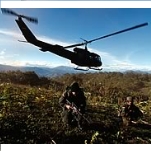The Andean Trade Preference Act (ATPA) was signed into law in 1991. It provided the countries of Bolivia, Colombia, Ecuador and Peru duty-free access to the US market for a wide range of products. ATPA was intended to promote economic alternatives to drug-crop production in the Andean region, help build the economies of regional trading partners and strengthen democracy and regional stability by giving governments tools to fight narco-terrorism.
Other observers say this points to the ultimate ineffectiveness of the plan in stopping the flow of drugs and addressing more important or underlying issues like providing a
viable alternative for landless and other peasants
, who turn to coca cultivation due to a lack of other economic possibilities, in addition to having to deal with the tumultuous civil conflict between the state, guerrillas and paramilitaries. They also say that simply making coca difficult to grow and transport in one area will lead to the movement of the drug cultivation processes to other areas, both inside and outside Colombia, a consequence also known as the
The Andean Counterdrug Initiative (ACI), a program within the State Department, is responsible for supporting anti-drug initiatives in Colombia and surrounding Andean nations. ACI’s policies are designed to strengthen democracy, increase stability in the region, help restore the faltering economies of Andean countries and eradicate coca crops by working with local farmers.
By reducing illegal drug trafficking, ACI also addresses national security in two ways, according to US officials. Programs designed to attack the source of 90% of the cocaine and 40% of the heroin entering the United States do no further social or economic damage to the poor, who often cultivate these crops out of necessity. Secondarily, these programs strengthen law enforcement and military institutions to maintain the balance of law. The State Department’s
International Narcotics and Law Enforcement Affairs Bureau
(INL) administers the eradication and interdiction components of the ACI program. The US Agency for International Development (USAID) administers the alternative development programs under ACI and contracts with private firms to conduct independent
evaluations of elements of its ACI programs in Bolivia and Colombia. USAID does not regularly schedule independent evaluations and has not contracted for evaluations of its programs in Peru or Ecuador, two of the four Andean countries in which it administers ACI programs.
According to the State Department’s Bureau of International Narcotics and Law Enforcement Affairs, which oversees the Andean Counterdrug Initiative, funding from the program (for 2005) was distributed to seven countries for counternarcotics and security (C&S) and economic and social development (E&S).
Venezuela = $2.9 million (all E&S)
The Military Component
Colombia probes cocaine smuggling by US troops
(AFP/Reuters)
- Table of Contents
- Overview
- History
- What it Does
- Where Does the Money Go
- Controversies
- Suggested Reforms
- Comments
- Leave a comment


A native of Georgia, David T. Johnson has served since October 2007 as the assistant secretary for the Bureau of International Narcotics and Law Enforcement Affairs. In this capacity, Johnson oversees the Andean Counterdrug Initiative.
- Latest News
- D.C. Public Schools will Teach all Second-Graders to Ride a Bike
- New Rule in Germany Limits Sales of Sex-Themed E-Books to 10pm to 6am
- What Happened to the 6-Year-Old Tibetan Boy the Chinese Government Kidnapped 20 Years Ago?
- U.S. Ambassador to Turkey Photoshops his Hair Color to Mock Turkish Mayor
- Mystery Artist Calls Attention to Unfixed Potholes by Drawing Penises around Them
The Andean Trade Preference Act (ATPA) was signed into law in 1991. It provided the countries of Bolivia, Colombia, Ecuador and Peru duty-free access to the US market for a wide range of products. ATPA was intended to promote economic alternatives to drug-crop production in the Andean region, help build the economies of regional trading partners and strengthen democracy and regional stability by giving governments tools to fight narco-terrorism.
Other observers say this points to the ultimate ineffectiveness of the plan in stopping the flow of drugs and addressing more important or underlying issues like providing a
viable alternative for landless and other peasants
, who turn to coca cultivation due to a lack of other economic possibilities, in addition to having to deal with the tumultuous civil conflict between the state, guerrillas and paramilitaries. They also say that simply making coca difficult to grow and transport in one area will lead to the movement of the drug cultivation processes to other areas, both inside and outside Colombia, a consequence also known as the
The Andean Counterdrug Initiative (ACI), a program within the State Department, is responsible for supporting anti-drug initiatives in Colombia and surrounding Andean nations. ACI’s policies are designed to strengthen democracy, increase stability in the region, help restore the faltering economies of Andean countries and eradicate coca crops by working with local farmers.
By reducing illegal drug trafficking, ACI also addresses national security in two ways, according to US officials. Programs designed to attack the source of 90% of the cocaine and 40% of the heroin entering the United States do no further social or economic damage to the poor, who often cultivate these crops out of necessity. Secondarily, these programs strengthen law enforcement and military institutions to maintain the balance of law. The State Department’s
International Narcotics and Law Enforcement Affairs Bureau
(INL) administers the eradication and interdiction components of the ACI program. The US Agency for International Development (USAID) administers the alternative development programs under ACI and contracts with private firms to conduct independent
evaluations of elements of its ACI programs in Bolivia and Colombia. USAID does not regularly schedule independent evaluations and has not contracted for evaluations of its programs in Peru or Ecuador, two of the four Andean countries in which it administers ACI programs.
According to the State Department’s Bureau of International Narcotics and Law Enforcement Affairs, which oversees the Andean Counterdrug Initiative, funding from the program (for 2005) was distributed to seven countries for counternarcotics and security (C&S) and economic and social development (E&S).
Venezuela = $2.9 million (all E&S)
The Military Component
Colombia probes cocaine smuggling by US troops
(AFP/Reuters)
Comments


A native of Georgia, David T. Johnson has served since October 2007 as the assistant secretary for the Bureau of International Narcotics and Law Enforcement Affairs. In this capacity, Johnson oversees the Andean Counterdrug Initiative.
- Latest News
- D.C. Public Schools will Teach all Second-Graders to Ride a Bike
- New Rule in Germany Limits Sales of Sex-Themed E-Books to 10pm to 6am
- What Happened to the 6-Year-Old Tibetan Boy the Chinese Government Kidnapped 20 Years Ago?
- U.S. Ambassador to Turkey Photoshops his Hair Color to Mock Turkish Mayor
- Mystery Artist Calls Attention to Unfixed Potholes by Drawing Penises around Them





Comments